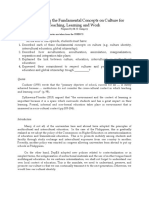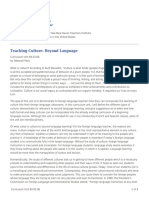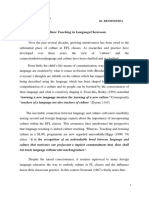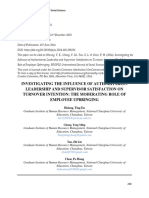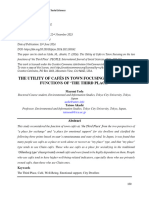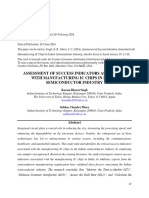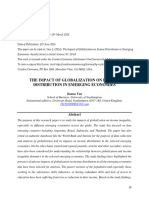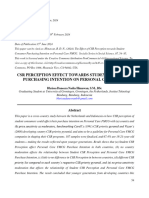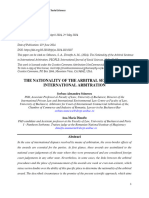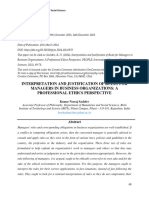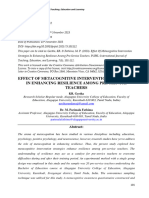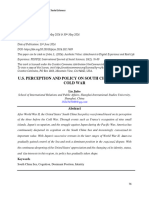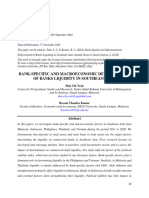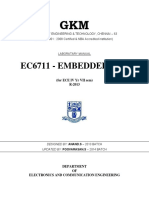Bridging The Barriers in British Culture
Bridging The Barriers in British Culture
Uploaded by
Global Research and Development ServicesCopyright:
Available Formats
Bridging The Barriers in British Culture
Bridging The Barriers in British Culture
Uploaded by
Global Research and Development ServicesOriginal Title
Copyright
Available Formats
Share this document
Did you find this document useful?
Is this content inappropriate?
Copyright:
Available Formats
Bridging The Barriers in British Culture
Bridging The Barriers in British Culture
Uploaded by
Global Research and Development ServicesCopyright:
Available Formats
PEOPLE: International Journal of Social Sciences
ISSN 2454-5899
Nadjouia Hallouch, 2019
Volume 5 Issue 2, pp. 285-292
Date of Publication: 26th August 2019
DOI-https://dx.doi.org/10.20319/pijss.2019.52.285292
This paper can be cited as: Hallouch, N., (2019). Bridging the Barriers in British Culture. PEOPLE:
International Journal of Social Sciences, 5(2), 285-292.
This work is licensed under the Creative Commons Attribution-Non Commercial 4.0 International
License. To view a copy of this license, visit http://creativecommons.org/licenses/by-nc/4.0/ or send a
letter to Creative Commons, PO Box 1866, Mountain View, CA 94042, USA.
BRIDGING THE BARRIERS IN BRITISH CULTURE
Nadjouia Hallouch
Department of English, Djillali Liabes University, Sidi-Bel-Abbes, Algeria
hallouch14@yahoo.com
Abstract
There is a general observation among officials that the conflict between cultures has been
dramatically increasing. This can be related to a whole set of reasons including: cultural
unawareness, prejudice, the ignorance of differences in values, norms and beliefs and the media.
The module of British culture is taught at the Departments of English in the Algerian universities
from the first year. Many students think that in the course of British culture, the teacher is the only
performer whose duty is to give them information about the target culture. Teaching British culture
does not require from the teacher transmitting only information but developing positive attitudes,
skills and awareness of values of this culture (Byram, Gribkova, & Starkey, 2002). The questions
which are raised here are: are we as teachers of British culture preparing our students for a
successful intercultural communication? Are we helping our students to develop their cultural
awareness? This research paper was carried out through a questionnaire applied to second year
students in British culture in particular to assess their cultural awareness. It focusses on the role
of the teacher in helping students bridging the barriers and enabling them to interact successfully
with people from other cultures.
Keywords
Culture, Prejudice, Values, Cultural Awareness, Communicative Competence
Available Online at: http://grdspublishing.org/ 285
PEOPLE: International Journal of Social Sciences
ISSN 2454-5899
1. Introduction
Today many teachers are afraid of teaching the module of culture because their knowledge
is limited. Providing students with information about the target culture, and enabling them to have
a clear conception are among the main objectives of teaching British culture but this is not all what
our students need. Nowadays, due to the globalization era and especially with the increase of the
conflict between cultures, teachers of British culture should recognize the need to teach their
students cultural perspectives namely attitudes, values and beliefs. The aim behind the introduction
of such perspectives is to enable our students to respect, tolerate, understand and communicate
successfully with people from other cultures. According to (Lopez, 2016: p107): “A person who
has developed intercultural communicative competence is able to build relationships while
speaking in the foreign language; communicate effectively, taking into consideration his own and
the other person’s viewpoint and needs; mediates interactions between people of different
backgrounds and strives to continue developing communicative skills”. Peck (1984) states that
“the study of different cultures aids us to know different peoples which is a necessary prelude to
understanding and respecting other peoples and their way of life”. The objective of the present
paper is to help teachers of British culture understand that it is their role to prepare students to be
good future intercultural communicators by arousing their cultural awareness. In so doing, we first
define the word culture, and then we examine the objectives of teaching British culture with
reference to cultural communicative competence and cultural awareness.
2. What is Culture?
There are hundreds of definitions of the word culture which show that it is “a very broad
concept embracing all aspects of human life” (Seelye, 1993:15). According to (Brown, 1963),
culture is “what binds people together”. Kramsch (1998:10) defines culture as “a common system
of standards for perceiving, evaluating, and acting”. For (Byram 1997), the elements of the ‘big
C’ include history, geography, institutions, literature, art and music and the way of life. The
behaviour culture or ‘little c’ focusses on the behavioural pattern and life styles of everyday people.
Vegh (2019) cites three aspects of culture namely: material (tools, foods and goods), social
(language, religion and law) and physical (norms, attitudes and values). Seelye (1993) provides us
with three components of culture which are expressed through the following diagram:
Available Online at: http://grdspublishing.org/ 286
PEOPLE: International Journal of Social Sciences
ISSN 2454-5899
Perspectives Beliefs, Values
Attitudes
Products Practices
Sculpture
Painting Patterns of behaviour
a piece of literature accepted by a society
dance
education system
Figure 1: Cultural Components
Source: Seelye, H. N, 1993, p 5
3. What are the Objectives of Teaching Culture?
Teaching culture ‘should not aim at only giving information about the foreign culture,
which is evident during foreign language teaching” (Ciornei, & Tamga, 2013: 1920). The teacher
of culture has also to give the learner the opportunity “to develop cultural knowledge, awareness
society
and competence in such a way that might lead to better understanding of the foreign culture, the
other as well as the learner’s own culture, the self “(Ciornei, & Tamga, 2013: 1920). Seelye (1993)
points out that teaching culture ‘provides a framework for facilitating the development of cross-
cultural communication skills.
Today, our students are living in the globalization era. Many of them have British friends,
some travel abroad while others plan to finish their studies in Britain. In fact, there is still in many
countries intolerance towards and prejudice against other cultures. Therefore, an intercultural
education might be a solution to promote tolerance, acceptance, understanding and respect.
It is not the aim of the teacher of British culture to ‘change the students values but to make
them explicit and conscious in any evaluative response to others’ (Byram, Gribkova, & Starkey,
2002). (Byram, 1993: 11) points out that “Misunderstandings are likely to occur between members
Available Online at: http://grdspublishing.org/ 287
PEOPLE: International Journal of Social Sciences
ISSN 2454-5899
of different cultures; … differences are real and we must learn to deal with them in any situation
in which two cultures come into contact”. The question which is raised here is: -Are we as teachers
of British culture helping our students to achieve a successful intercultural communication?
4. What is the Intercultural Communicative Competence?
According to many language teaching professionals, intercultural competence was an
extended as intercultural communicative competence (Lazar, et al., 2007). Lopez (2016) mentions
that the intercultural competence is defined as “people’s ability to interact in their own language
with people from another country and culture” whereas the intercultural communicative
competence “focusses on the ability to interact with people from another country and culture in a
foreign language”. According to (Lazar, et al., 2007:9), the intercultural communicative
competence “requires certain attitudes, knowledge and skills as well as linguistic, sociolinguistic
and discourse competence”. In order to achieve a successful communicative competence, he
mentions five constructs that should be taken into consideration including “awareness, attitudes,
skills, knowledge and language proficiency”. He also provides us with some qualities which
describe the intercultural speaker including: “respect, empathy, flexibility, patience, interest,
curiosity, openness, motivation, a sense of humour, tolerance for ambiguity, and a willingness to
suspend judgement”.
Intercultural competence was the subject of the document of the Council of Europe (Jan
2001). The aim was that “mutual understanding and intercultural competence are more important
than ever today” (Barrett, Byram, Lazar, Gaillard, & Philippou, 2014). Besides this, intercultural
competence provides a foundation for being a global citizen. Despite all the recommendations,
many teachers are still relying on grammatical and lexical competence. It is important to produce
correct English either in speaking or writing but does fluency alone help our students to interact
successfully with people from other cultures? The traditional method of teaching culture becomes
no longer efficient. The teacher of British culture should focus on attitudes, values and beliefs
instead of relying on only cultural products and practices.
One of the main objectives of teaching British culture is to enable students to communicate
with people from a different cultural and linguistic background. To achieve this, the teacher has
first to help his student acquire information and develop his cultural awareness.
Available Online at: http://grdspublishing.org/ 288
PEOPLE: International Journal of Social Sciences
ISSN 2454-5899
5. What is the Cultural Awareness and How Can We Develop It?
Damen (1987) says that “cultural awareness involves uncovering and understanding one’s
own cultural conditioned behaviour and thinking, as well as the patterns of others”. This means
that the process involves recognizing the givens of our culture as well as perceiving the similarities
and differences of the foreign culture. Cultural awareness as defined by (Tomalin & Stempleski,
1998:5) is “sensitivity to the impact of cultural induced behaviour on language use and
communication”. It is considered as the foundation of communication and involves the awareness
of one’s own culture and of the other one (Zhu: 2011). Cultural awareness becomes essential when
we communicate with people from different cultures (Mengenai, 2012).
It is the teacher’s role to make students aware of cultural differences. What is considered
as an appropriate behaviour in one culture is most of the time inappropriate in another one. In
Algeria for example, people kiss each other and this is not the case in Britain. We also shake hands
tens of time a day when we meet a friend. It is not the case in England. In other terms we should
know how people create something elsewhere and behave consequently either in conformity or
not.
Peck (1984) says that our students “want to touch, smell and see the British culture”.
Offering them the chance to achieve this is our role as teachers of British culture. The teacher has
to develop the cultural awareness of the students by making them aware of cultural differences.
The reason behind this is to familiarize learners with the cultural components. Aspects to explore
religion and etiquette are of a great help to promote cultural awareness. Examination of pictures,
the use of currency and stamps, reading of original texts and engaging students in activities
focussing on the life styles of people and on what people do in common situations will introduce
cultural elements into the classroom and increase curiosity and awareness.
Most of the Algerian students see the British as cold, serious and competent. I usually
enter the classroom ten minutes before the lecture. This led many of my students to tell me this
expression: “Oh Miss you respect time like the British people”. It is clear that most Algerian
students of English know that the British people respect time.
In order to assess students’ cultural awareness, I prepared a questionnaire which included
four questions and I asked 20 students to answer them. The questions were as follows:
- How do the British people behave in :
1- Greetings
2- Gift giving
Available Online at: http://grdspublishing.org/ 289
PEOPLE: International Journal of Social Sciences
ISSN 2454-5899
3- Public places
4- Queuing
I faced a negative attitude from two students. The first said: Miss please we have our own
principles, traditions and beliefs. Are we supposed to follow the British ones? The second said:
“Miss you are so fascinated by the British people”. I had to explain them that it is not the object of
the questionnaire to change their principles.
Table 1: Students’ Questionnaire Results
Questions Responses Number of Percentage
Students
They shake hands
1 They say hello 17 85
They exchange chocolate and flowers
2 6 30
They respect the others
3 They answer politely if you need a help 9 45
4 They respect the queue 16 80
It is clear from the table that the majority of students know how the British people behave
in greetings and queuing. Only 30% know how the British people behave in gift giving whereas
45 % are aware of British behaviour in public places. Though students were asked to answer only
the questionnaire, some of them made a comparison between British and Algerian behaviour. This
shows that students are aware of the great differences which exist between the two cultures.
6. Conclusion
To sum up, in order to overcome the barriers in intercultural communication, we as teachers
of British culture, need to provide our students with knowledge about the British people and help
them to be tolerant, to accept, understand and respect them. Hall.T (1959) points out that “it is the
hidden elements which are responsible for culture shock and misunderstanding”. Once, the student
understands that people are not the same and that differences can exist even between members of
the same society, he will be able to respect the other. (Arabski &Wojtaszek 2011) state that “to
Available Online at: http://grdspublishing.org/ 290
PEOPLE: International Journal of Social Sciences
ISSN 2454-5899
communicate interculturally students need various kinds of skills, attitudes and cultural
awareness” .Teachers’ challenges in teaching British culture can be the object of another paper.
References
B. Tomalin & C, Stempleski.(1998). Cultural Awareness, Oxford, Oxford University Press.
C, Kramsch. (1998). Language and Culture, Oxford, Oxford University Press.
D, Peck. (1984). Teaching Culture: Beyond Language.
http://www.Yale.edu/ynhti/curriculum/units/1984/3/84.03.6x.html
E.T, Hall. (1989). Beyond Culture, USA, Anchor Books.
H.N, Seelye. (1993). Teaching Culture: Strategies for Intercultural Communication, (3rd ed),
Lincolnwood, IL: National Textbook Company.
H. Zhu, (2011). From Intercultural Awareness to Intercultural Empathy, English Language
Teaching, V4, (1) Canadian Center of Sciences and Education.
https://doi.org/10.5539/elt.v4n1p116
I.C, Brown. (1963). Understanding Other Cultures. New Jersey: Prentice Hall, Inc.
I. Lazar, et al., (2007). Developing and Assessing Intercultural Communicative Competence,
Strasbourg, the Council of Europe.
I.S, Ciornei & T.M, Tamaga. (2013). “Effective Ways of Teaching British Culture and
Civilisation”, Procedia- Social and Behavioral Sciences, 70, 1919-1924, in M, Byram.
(1997), p 57. https://doi.org/10.1016/j.sbspro.2013.01.270
J. Arabski & A, Wojtaszek. (2011) Aspects of Culture in Second Language Acquisition and
Foreign Language Learning, Poland, Springer. https://doi.org/10.1007/978-3-642-20201-8
L, Damen, (1987). Culture Learning: The Fifth Dimension in the Language Classroom, United
Kingdom, Pearson Educated Limited.
M, Barrett, M, Byram, I, Lazar, I, P, Mompoint- Gaillard, & S, Philippou. (2014). Developing
Intercultural Competence through Education, Strasbourg: the Council of Europe.
M, Byram. (1993), Teaching and Learning Language and Culture, Ourham, in I.C, Brown, p123.
M, Byram. (1997), Teaching and Assessing Intercultural Communicative Competence, Clevedon,
England: Multilingual Matters.
M, Byram, B,Gribkova, & H,Starkey. (2002) Developing the Intercultural Dimension in Language
Teaching: a practical introduction for teachers, Strasbourg: The Council of Europe.
Available Online at: http://grdspublishing.org/ 291
PEOPLE: International Journal of Social Sciences
ISSN 2454-5899
R. S, Lopez. (2016). Intercultural Communicative Competence: creating awareness and promoting
skills in the Language Classroom. In C. Goria,O. Speicher, & S, Stolhans (Eds), Innovative
Language Teaching and Learning at University: enhancing participation and
collaboration (105-111). Dublin: Research publishing.net.
http://dx.doi.org/10.14705/rpnet.2016.000411, in M, Byram, 1997.
https://doi.org/10.14705/rpnet.2016.000411
S, Mengenai. (2012), Developing Culture Awareness in English Language Teaching, RABU.
Vegh, J & Luu, L.A.N. (2019). Intercultural Competence Development Models- Theory and
Practice through Comparative Analysis. PEOPLE: International Journal of Social
Sciences, 4(3), 882-901. https://doi.org/10.20319/pijss.2019.43.882901
Available Online at: http://grdspublishing.org/ 292
You might also like
- Module 3 Multicultural and Global LiteracyDocument21 pagesModule 3 Multicultural and Global LiteracyJM Paguigan100% (8)
- Grfthyex 1Document2 pagesGrfthyex 1Luk TseManNo ratings yet
- OXF ModelDocument435 pagesOXF Modelmohan_v_sNo ratings yet
- Intercultural CommunicationDocument6 pagesIntercultural CommunicationelenaNo ratings yet
- Developing Intercultural Literacy in The PDFDocument17 pagesDeveloping Intercultural Literacy in The PDFEdwinNo ratings yet
- Practices in Intercultural Language Teaching and LearningDocument30 pagesPractices in Intercultural Language Teaching and LearningIarisma ChavesNo ratings yet
- Developing Cultural AwarenessDocument6 pagesDeveloping Cultural AwarenessLilia PerezNo ratings yet
- What Is Culture, and How Can We Develop A Culturally Competent Attitude?Document3 pagesWhat Is Culture, and How Can We Develop A Culturally Competent Attitude?Vivit RosmayantiNo ratings yet
- EDUC 122 Module 3 Global and Multi Cultural LiteracyDocument4 pagesEDUC 122 Module 3 Global and Multi Cultural Literacyjanlyn davidNo ratings yet
- 4-The Most Common Approaches To The Teaching of CultureDocument6 pages4-The Most Common Approaches To The Teaching of CultureSouhaila DjaffalNo ratings yet
- The 3rd Indonesian International Conference On Linguistics, Language Teaching, Literature and CultureDocument8 pagesThe 3rd Indonesian International Conference On Linguistics, Language Teaching, Literature and CultureMarwahNo ratings yet
- The Role of Culture in Teaching and Learning of English As A Foreign LanguageDocument14 pagesThe Role of Culture in Teaching and Learning of English As A Foreign LanguageKhoa NguyenNo ratings yet
- Jackie F. K. Lee and Xinghong LiDocument20 pagesJackie F. K. Lee and Xinghong Liarifinnur21No ratings yet
- Investigating The Relevance of Language and Culture: Language Teaching in Cultural ContextDocument10 pagesInvestigating The Relevance of Language and Culture: Language Teaching in Cultural ContextBEeNaNo ratings yet
- Profed 322 Reviewer.Document16 pagesProfed 322 Reviewer.DianneNo ratings yet
- Makhmud Ov Science and Education Issue 4Document7 pagesMakhmud Ov Science and Education Issue 4Francisco GarridoNo ratings yet
- Collaborative Action ResearchDocument7 pagesCollaborative Action ResearchCynthia AguirreNo ratings yet
- 4.1-Culture-and-FLT-Goals-Approaches-Techniques (1) (1)Document7 pages4.1-Culture-and-FLT-Goals-Approaches-Techniques (1) (1)mano manoNo ratings yet
- Teaching Culture in EFL: Implications, Challenges and StrategiesDocument6 pagesTeaching Culture in EFL: Implications, Challenges and StrategiesANDREA VERA CORRALESNo ratings yet
- Teaching Cultural Concepts Through LanguageDocument6 pagesTeaching Cultural Concepts Through LanguageResearch ParkNo ratings yet
- Fundamental Concepts On CultureDocument6 pagesFundamental Concepts On CultureWazer WifleNo ratings yet
- Lesson 2 Globalization and Multicultural LiteracyDocument52 pagesLesson 2 Globalization and Multicultural LiteracyRodelin Manding100% (1)
- Cultural representation in English language textbooks a comparison of textbooks used in mainland China and Hong KongDocument20 pagesCultural representation in English language textbooks a comparison of textbooks used in mainland China and Hong KongPhuong Linh LeNo ratings yet
- Intercultural UnderstandingDocument13 pagesIntercultural Understandingronald karl andianoNo ratings yet
- 4-Culture-and-FLT (1)Document11 pages4-Culture-and-FLT (1)mano manoNo ratings yet
- Raising Cultural Awareness in The English ClassroomDocument11 pagesRaising Cultural Awareness in The English ClassroomJavi JoShNo ratings yet
- General and Specific Culture Learning in Efl Textbooks Aimed at Adult Learners in SpainDocument21 pagesGeneral and Specific Culture Learning in Efl Textbooks Aimed at Adult Learners in Spainantonio.raigon74No ratings yet
- 26 Raising EFL Teachers' Awareness About The Enhancement of Learners' Intercultural Communication Through Teaching Intercultural LinguisticsDocument14 pages26 Raising EFL Teachers' Awareness About The Enhancement of Learners' Intercultural Communication Through Teaching Intercultural LinguisticsAbdaouiNo ratings yet
- Materials For Teaching CultureDocument28 pagesMaterials For Teaching CultureNozima ToirovaNo ratings yet
- Global and Multicultural LiteracyDocument3 pagesGlobal and Multicultural Literacyrollence100% (1)
- Teaching and Learning CultureDocument6 pagesTeaching and Learning CultureAngelds100% (1)
- Teaching EILDocument5 pagesTeaching EILAnna ZvyaginaNo ratings yet
- Lomonosov Moscow State University: 5. Intercultural Communication and Methods of Teaching A Foreign LanguageDocument11 pagesLomonosov Moscow State University: 5. Intercultural Communication and Methods of Teaching A Foreign LanguageOleg SilveriNo ratings yet
- British Vs AmericanDocument40 pagesBritish Vs AmericanBELKYSNo ratings yet
- Peck D, 1998Document9 pagesPeck D, 1998Rafael LeeNo ratings yet
- Teaching Culture Through Advertising: Ana Viale MoutinhoDocument8 pagesTeaching Culture Through Advertising: Ana Viale MoutinhoBetea RebecaNo ratings yet
- Chapter 1: Introduction To Multicultural EducationDocument2 pagesChapter 1: Introduction To Multicultural EducationCM Soriano TalamayanNo ratings yet
- Teaching Culture Strategies in EFL Classroom: March 2017Document21 pagesTeaching Culture Strategies in EFL Classroom: March 2017Ghada MajidNo ratings yet
- 4 Culture TeachingDocument4 pages4 Culture TeachingmimaNo ratings yet
- Cross-Cultural Communication (Also Frequently Referred To AsDocument8 pagesCross-Cultural Communication (Also Frequently Referred To AsMonish NewarNo ratings yet
- Hafta, Di̇l Ve Edebi̇yat Öğreti̇mi̇ 2Document46 pagesHafta, Di̇l Ve Edebi̇yat Öğreti̇mi̇ 2osm6navniNo ratings yet
- English Literature and Language ReviewDocument6 pagesEnglish Literature and Language ReviewTHEA URSULA EMANUELLE RACUYANo ratings yet
- Teaching Culture in EFL: Implications, Challenges and StrategiesDocument5 pagesTeaching Culture in EFL: Implications, Challenges and StrategiesPhúc ĐoànNo ratings yet
- Definition of CultureDocument11 pagesDefinition of CultureFitrah Elisa100% (2)
- Adolescencia Una Etapa Fundamental en Unicef 9-08-2018Document16 pagesAdolescencia Una Etapa Fundamental en Unicef 9-08-2018joseNo ratings yet
- An Interculture Communication TextbookDocument102 pagesAn Interculture Communication TextbookTuyenLeNo ratings yet
- Culture in SecondDocument7 pagesCulture in SecondAbderrahmane BabniNo ratings yet
- The Role of Intercultural Communication in Teaching Foreign LanguagesDocument5 pagesThe Role of Intercultural Communication in Teaching Foreign LanguagesMi ChanNo ratings yet
- Keskass Aitaissa PDFDocument27 pagesKeskass Aitaissa PDFMarouaNo ratings yet
- The Role of Culture in English LanguageDocument8 pagesThe Role of Culture in English LanguageHong NhungNo ratings yet
- English Project EditedDocument23 pagesEnglish Project Editeddawn.ari04No ratings yet
- Local and Global Communication in Multicultural SettingsDocument10 pagesLocal and Global Communication in Multicultural SettingsJELICEL ATENo ratings yet
- EDUC13-SDE-ChapterIII-InterculturalCommunicationby PALILLO, JohnaADocument3 pagesEDUC13-SDE-ChapterIII-InterculturalCommunicationby PALILLO, JohnaAJanah Janah PNo ratings yet
- Chapter 3 PurcomDocument10 pagesChapter 3 PurcomHerbert Jhon NazalitaNo ratings yet
- Problematizing The Idea of Curriculum inDocument5 pagesProblematizing The Idea of Curriculum inshireenfNo ratings yet
- Culture in Foreign Language Teaching and LearningDocument9 pagesCulture in Foreign Language Teaching and LearningBella WintaNo ratings yet
- Chapter 3 PurcomDocument11 pagesChapter 3 Purcomromel jerichoNo ratings yet
- International Education - International Culture: Education, #1From EverandInternational Education - International Culture: Education, #1No ratings yet
- Unit 1.moocDocument11 pagesUnit 1.moocr.hatdogcheesedogNo ratings yet
- Terms of Use, Available at - Downloaded From - University of Connecticut, On 17 Aug 2020 at 02:15:48, Subject To The Cambridge CoreDocument6 pagesTerms of Use, Available at - Downloaded From - University of Connecticut, On 17 Aug 2020 at 02:15:48, Subject To The Cambridge CoreMan BidamNo ratings yet
- 1016 1056 1 PBDocument11 pages1016 1056 1 PBLisda NurjalekaNo ratings yet
- Investigating The Influence of Authoritarian Leadership and Supervisor Satisfaction On Turnover Intention: The Moderating Role of Employee UpbringingDocument24 pagesInvestigating The Influence of Authoritarian Leadership and Supervisor Satisfaction On Turnover Intention: The Moderating Role of Employee UpbringingGlobal Research and Development ServicesNo ratings yet
- The Utility of Cafés in Town Focusing On The Two Functions of The Third Place'Document13 pagesThe Utility of Cafés in Town Focusing On The Two Functions of The Third Place'Global Research and Development ServicesNo ratings yet
- Perceived Cognitive Load of Extended Reality Serious Educational Games About Climate ChangeDocument19 pagesPerceived Cognitive Load of Extended Reality Serious Educational Games About Climate ChangeGlobal Research and Development ServicesNo ratings yet
- Assessment of Success Indicators Associated With Manufacturing Ic Chips in Indian Semiconductor IndustryDocument12 pagesAssessment of Success Indicators Associated With Manufacturing Ic Chips in Indian Semiconductor IndustryGlobal Research and Development ServicesNo ratings yet
- Design of A Website To Support The Teaching-Learning Process of GeneticsDocument16 pagesDesign of A Website To Support The Teaching-Learning Process of GeneticsGlobal Research and Development ServicesNo ratings yet
- Content Slicing: Low-Code Management of Video, Graphics and More For Engaging ClassroomsDocument15 pagesContent Slicing: Low-Code Management of Video, Graphics and More For Engaging ClassroomsGlobal Research and Development ServicesNo ratings yet
- The Impact of Globalization On Income Distribution in Emerging EconomiesDocument25 pagesThe Impact of Globalization On Income Distribution in Emerging EconomiesGlobal Research and Development ServicesNo ratings yet
- CSR Perception Effect Towards Student Consumer Purchasing Intention On Personal Care FMCGDocument32 pagesCSR Perception Effect Towards Student Consumer Purchasing Intention On Personal Care FMCGGlobal Research and Development Services100% (1)
- Examine The Effects of Goods and Services Tax (GST) and Its Compliance: Reference To Sierra LeoneDocument18 pagesExamine The Effects of Goods and Services Tax (GST) and Its Compliance: Reference To Sierra LeoneGlobal Research and Development ServicesNo ratings yet
- Methodology For Research-Informed Teaching and Learning in Electronics EngineeringDocument15 pagesMethodology For Research-Informed Teaching and Learning in Electronics EngineeringGlobal Research and Development ServicesNo ratings yet
- The Nationality of The Arbitral Sentence in International ArbitrationDocument7 pagesThe Nationality of The Arbitral Sentence in International ArbitrationGlobal Research and Development ServicesNo ratings yet
- Analyzing The Relationship Between Industrial Policy and Entrepreneurial EcosystemDocument13 pagesAnalyzing The Relationship Between Industrial Policy and Entrepreneurial EcosystemGlobal Research and Development ServicesNo ratings yet
- Research On Aesthetic Cognition, Flow Experience and Technology Acceptance in Virtual Cultural ActivitiesDocument16 pagesResearch On Aesthetic Cognition, Flow Experience and Technology Acceptance in Virtual Cultural ActivitiesGlobal Research and Development ServicesNo ratings yet
- Interpretation and Justification of Rules For Managers in Business Organizations: A Professional Ethics PerspectiveDocument10 pagesInterpretation and Justification of Rules For Managers in Business Organizations: A Professional Ethics PerspectiveGlobal Research and Development ServicesNo ratings yet
- Effect of Metacognitive Intervention Strategies in Enhancing Resilience Among Pre-Service TeachersDocument12 pagesEffect of Metacognitive Intervention Strategies in Enhancing Resilience Among Pre-Service TeachersGlobal Research and Development ServicesNo ratings yet
- Potential Factors Influence Failure of The Village-Owned Business: The Entity Village Autonomy of Indonesian Government's ProgramDocument12 pagesPotential Factors Influence Failure of The Village-Owned Business: The Entity Village Autonomy of Indonesian Government's ProgramGlobal Research and Development ServicesNo ratings yet
- U.S. Perception and Policy On South China Sea Pre-Cold WarDocument14 pagesU.S. Perception and Policy On South China Sea Pre-Cold WarGlobal Research and Development ServicesNo ratings yet
- How Non-Curricular Arts Are Used To Strengthen The Social Status of EngineersDocument9 pagesHow Non-Curricular Arts Are Used To Strengthen The Social Status of EngineersGlobal Research and Development ServicesNo ratings yet
- Challenges in The Implementation of Schoolbased Management of Developing Schools: Basis For A Compliance FrameworkDocument14 pagesChallenges in The Implementation of Schoolbased Management of Developing Schools: Basis For A Compliance FrameworkGlobal Research and Development Services100% (1)
- Resolving A Realistic Middle Ground Towards The Sustainability Transition in The Global Political and Economic Landscape: A Comprehensive Review On Green CapitalismDocument29 pagesResolving A Realistic Middle Ground Towards The Sustainability Transition in The Global Political and Economic Landscape: A Comprehensive Review On Green CapitalismGlobal Research and Development ServicesNo ratings yet
- The Ethical Perception On Utang Na Loob As Basis of Voter's ChoiceDocument18 pagesThe Ethical Perception On Utang Na Loob As Basis of Voter's ChoiceGlobal Research and Development Services100% (1)
- Role of Leader in Educational ManagementDocument9 pagesRole of Leader in Educational ManagementGlobal Research and Development ServicesNo ratings yet
- Perceived Self-Efficacy and Academic Performance of Stem Senior High School StudentsDocument13 pagesPerceived Self-Efficacy and Academic Performance of Stem Senior High School StudentsGlobal Research and Development ServicesNo ratings yet
- Loss Analysis in Bread Production Process Using Material Flow Cost Accounting TechniqueDocument16 pagesLoss Analysis in Bread Production Process Using Material Flow Cost Accounting TechniqueGlobal Research and Development ServicesNo ratings yet
- Using Collaborative Web-Based Maps To Promote Geography Teaching and LearningDocument13 pagesUsing Collaborative Web-Based Maps To Promote Geography Teaching and LearningGlobal Research and Development ServicesNo ratings yet
- Influence of Iot On Smart LogisticsDocument12 pagesInfluence of Iot On Smart LogisticsGlobal Research and Development ServicesNo ratings yet
- Refining The English Syntax Course For Undergraduate English Language Students With Digital TechnologiesDocument19 pagesRefining The English Syntax Course For Undergraduate English Language Students With Digital TechnologiesGlobal Research and Development ServicesNo ratings yet
- Design and Implementation of An Arabic Braille Self-Learning WebsiteDocument17 pagesDesign and Implementation of An Arabic Braille Self-Learning WebsiteGlobal Research and Development ServicesNo ratings yet
- Regulation of Online Platforms, Intermediaries, and Markets in The European Union and ChinaDocument25 pagesRegulation of Online Platforms, Intermediaries, and Markets in The European Union and ChinaGlobal Research and Development ServicesNo ratings yet
- Bank-Specific and Macroeconomic Determinants of Banks Liquidity in Southeast AsiaDocument18 pagesBank-Specific and Macroeconomic Determinants of Banks Liquidity in Southeast AsiaGlobal Research and Development ServicesNo ratings yet
- Training: Willie Smits (Born February 22, 1957, inDocument6 pagesTraining: Willie Smits (Born February 22, 1957, inMutiara AzizNo ratings yet
- Missionaries and Cannibals Python AiDocument3 pagesMissionaries and Cannibals Python Ai21131A4433 MUTHA RESHMIKANo ratings yet
- Ezproxy ReferencemanualDocument114 pagesEzproxy Referencemanualwazzup105No ratings yet
- Skill Set Lean Six Sigma Orange Belt v3.2Document23 pagesSkill Set Lean Six Sigma Orange Belt v3.2Bhanuprasad sridharaNo ratings yet
- Xilinx Training CoursesDocument16 pagesXilinx Training Coursesnocaries9300No ratings yet
- Shushkewich 1991Document3 pagesShushkewich 1991Mandar SardesaiNo ratings yet
- Module - 1 Introduction Design of Sanitary SewersDocument32 pagesModule - 1 Introduction Design of Sanitary SewersFaran Masood FASTNUNo ratings yet
- MAT 363 Fall 2008 SyllabusDocument8 pagesMAT 363 Fall 2008 SyllabusRobert Talbert100% (2)
- Riverside MagDocument28 pagesRiverside MagChristian CristoNo ratings yet
- MATLAB Basics: CS 111 Introduction To Computing in Engineering and ScienceDocument29 pagesMATLAB Basics: CS 111 Introduction To Computing in Engineering and ScienceMurugananth Gopal RajNo ratings yet
- PWC Global Annual Review 2015Document64 pagesPWC Global Annual Review 2015Pappula Sandeep RajNo ratings yet
- English For Academic and Propfessional Purposes - L09Document10 pagesEnglish For Academic and Propfessional Purposes - L09iriszhykeNo ratings yet
- New Light On Yoga Da ColorDocument11 pagesNew Light On Yoga Da Coloradya_tripathi100% (1)
- SUMMATIVE MATH 4 TH QUARTER 2ndDocument4 pagesSUMMATIVE MATH 4 TH QUARTER 2ndSassa IndominationNo ratings yet
- RPH M27 - HAIWAN LIAR Selasa 2023Document3 pagesRPH M27 - HAIWAN LIAR Selasa 2023Nor Zulaikha Binti LaungahNo ratings yet
- Alur Pemeriksaan Radiologi Pada Pasien Atas Permintaan Sendiri (Aps)Document45 pagesAlur Pemeriksaan Radiologi Pada Pasien Atas Permintaan Sendiri (Aps)qmr gseNo ratings yet
- Thesis Statements How To and Graphic OrganizerDocument2 pagesThesis Statements How To and Graphic Organizerapi-165234075No ratings yet
- Ec6711 - Embedded Lab Manual 2017Document39 pagesEc6711 - Embedded Lab Manual 2017Rajkumar PerumalNo ratings yet
- Principles of Finned Tube Heat Exchanger Design For Enhanced Heat TransferDocument20 pagesPrinciples of Finned Tube Heat Exchanger Design For Enhanced Heat Transferunknown8787100% (1)
- Dr. Ram Manohar Lohiya National Law University, Lucknow.: Synopsis ONDocument5 pagesDr. Ram Manohar Lohiya National Law University, Lucknow.: Synopsis ONGulafshaNo ratings yet
- Workshop Agenda: Management SeriesDocument1 pageWorkshop Agenda: Management SeriesBALACHANDAR SNo ratings yet
- Iso 11339 2010Document9 pagesIso 11339 2010Bushra ShaukatNo ratings yet
- Tugas Menerjemahkan Bahasa Inggris Oleh Hanifah AntoniDocument2 pagesTugas Menerjemahkan Bahasa Inggris Oleh Hanifah AntoniHani AntonnyNo ratings yet
- Figurative Language Choice Project RubricsDocument5 pagesFigurative Language Choice Project Rubricsapi-300725023No ratings yet
- Buôi 41 (Thang12 - 2021) - PhotoDocument8 pagesBuôi 41 (Thang12 - 2021) - PhotoNgoc Thao VyNo ratings yet
- Birla Institute of Technology, Mesra, Ranchi-835215 (India) : Signature Not VerifiedDocument5 pagesBirla Institute of Technology, Mesra, Ranchi-835215 (India) : Signature Not VerifiedHarshit JainNo ratings yet
- SEMI-FINAL EXAMINATION English Grade 10Document5 pagesSEMI-FINAL EXAMINATION English Grade 10Bernadette Barroso Daquil100% (1)
- 11 Normal DistributionDocument19 pages11 Normal DistributionA.B. Cbm50% (2)




















